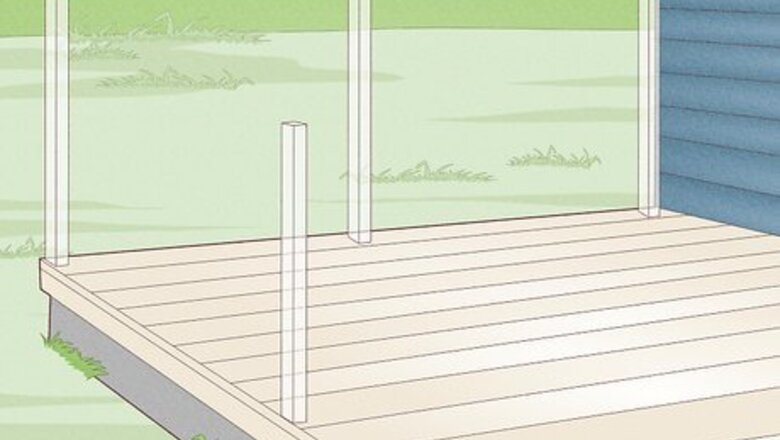
views
Installing Posts
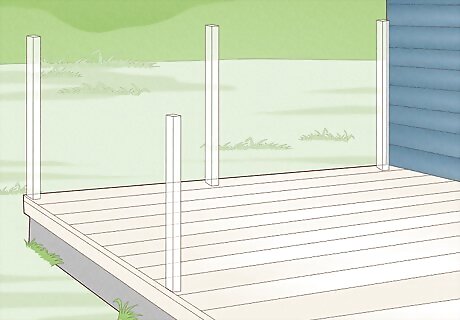
Count how many posts you will need. Your deck might already be supported by posts, especially if it is covered. If not, you’ll need to install these so that there will be something to support the railings. According to handyman Walter Brant, "A railing made with pressure-treated wood can span about 8 ft (2.4 m) between posts, while a PVC railing can only have 6 ft (1.8 m) of space between posts. PVC isn't as strong as wood; plus the PVC railings you want may only come in 6 ft (1.8 m) lengths."
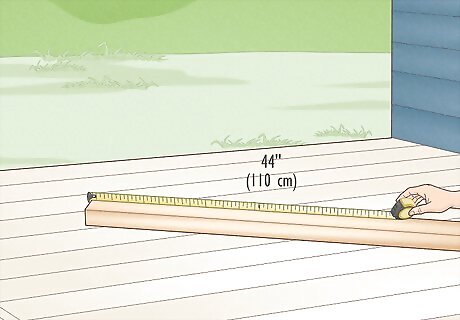
Measure out the posts. Cut 4x4s to be at least a little higher than the railing will be, plus extra length to hang below the deck planks. For instance, if you want a railing that is 36 inches (91 cm) high, cut posts that are perhaps 44 inches (110 cm) high. Most building codes require deck railings to be between 36 inches (91 cm) and 42 inches (110 cm) high. The posts' extra height above the railing is just for looks. An inch or two higher than the railing will look nice. You'll need enough length hanging below the surface of the deck to attach the posts securely to the supports. For instance, if your deck is made of boards that are 1 inch (2.5 cm) thick and the supports are 6 inches (15 cm) high, then you'll want your posts to be long enough to hang up to 7 inches (18 cm) but at least 4 inches (10 cm) below the railing Many people like to leave about 1.5 inches (3.8 cm) or so between the bottom railing and the deck boards as well, so factor this into the post height as well.
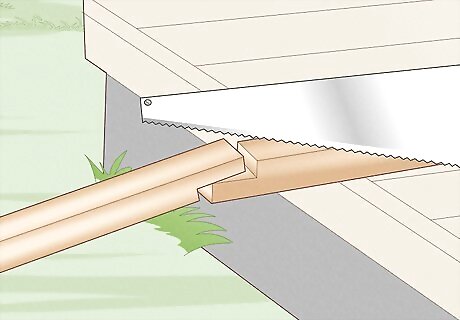
Cut the posts to have an overhang. Mark a line that goes several inches up the side of the bottom of each post. For instance, if you want your 4x4 posts to hang 4 inches (10 cm) over the edge of your deck, draw a line that far up the side, 2 inches (5.1 cm) from one side of the post (the midpoint of the post). Draw another line perpendicular to the first line's end. Use a saw and cut along the lines you drew to remove a section of the post that is 2 inches (5.1 cm) by 4 inches (10 cm).
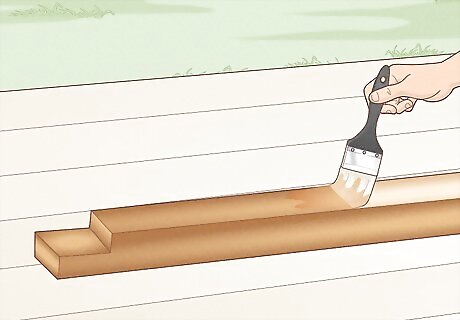
Apply finish to the posts. If you plan on finishing your deck rail, go ahead and apply the finish to the posts before installing. Brush the paint or stain on all sides of the posts and let them dry (about 24 hours).
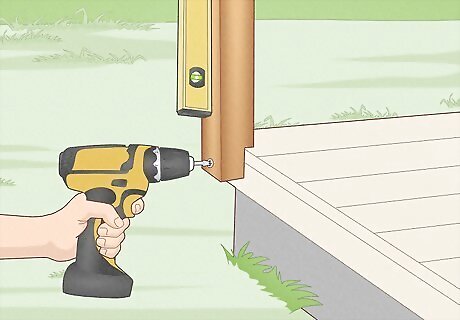
Mount the posts. Handyman Walter Brant suggests "holding a post in the position where it will be mounted and using a large level to hold it in a vertical position." Next, use a drill to form pilot holes through the overhang of the posts into the deck joists. Then, drill lag screws or carriage bolts into the pilot holes. If you will be using lag screws, Brant advises "using two ⁄2 in (1.3 cm)-diameter galvanized screws with washers, which are rust-proof. Drill ⁄2 in (1.3 cm) holes through the post, followed by ⁄8 in (0.95 cm) pilot holes into the board behind the post." If you will use lag bolts, use two ⁄2 in (1.3 cm)-diameter galvanized lag bolts with waters and nuts. Washers are used only on the ends of the bolts with the nuts. Drill ⁄2 in (1.3 cm) holes through the post and the board behind it. If the posts will be higher than the railing (the railings will not be nailed to the tops of the posts), nail a metal or wooden post cap onto the top of the railing. This prevents water from entering at the top.
Measuring and Cutting the Wood
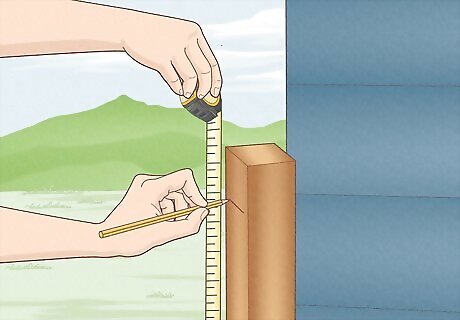
Mark the railing height on the posts. Using a tape measure, make a pencil mark in the center of each post. This will probably be between between 36 inches (91 cm) and 42 inches (110 cm), according to your preference and building codes. Many homeowners like to leave a couple of inches open below the bottom of the railing. To compensate for this, set the railing height mark slightly higher than the height of the railing itself. For instance, if you want a railing that is about 36 inches (91 cm) high, make marks on the posts at 40 inches (100 cm). That will leave enough room for the balusters, the top and bottom of the rail, and a couple inches open at the bottom.
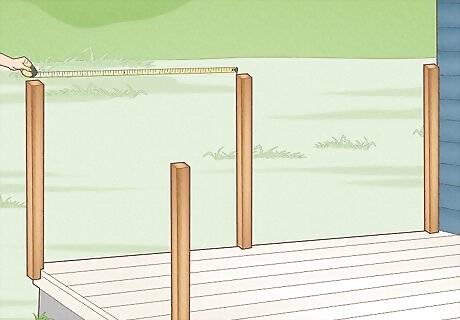
Measure the distance between the posts. If you didn’t install the posts yourself, you’ll need to know the exact distance between them so that you can cut the railing pieces to size. You’ll need a helper for this. Ask your helper to hold one end of the tape measure in place against the center of a post. Stretch the tape measure tightly across to the center of the next post and make a mark. Record the distance between the posts. Check the distance where you want the top and bottom rails to sit. If your posts are straight, the distance should be the same. If they're not, change the length of the rails to match the actual distance.
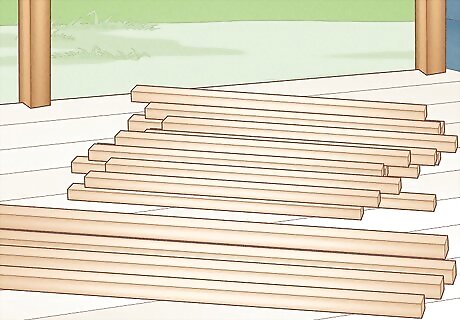
Get balusters and wood for the handrail. Take a trip down to the lumber supply store. You’ll need to get several pieces pre-cut or cut them to size yourself. You can also ask the supply store to cut it to size for you. Handyman Walter Brant suggests "using a miter saw if you plan on cutting the rails and handrails yourself." Cut 1x3 or 2x4 lumber into lengths equal to the distance between your deck posts. You’ll need two pieces for each length of railing (one for the bottom and another for the top). Get plenty of 2x2 balusters to use for the railing. You’ll want to space these no more than 4 inches (10 cm) apart. The length of the balusters should be approximately the height you want the railing to be. If they’re too long, cut them down. You’ll also need thin strips of wood. Get something that is about 0.25 inches (0.64 cm) by 1.5 inches (3.8 cm). Cut it into lengths equal to the distance between the deck posts. You’ll need one strip per section.
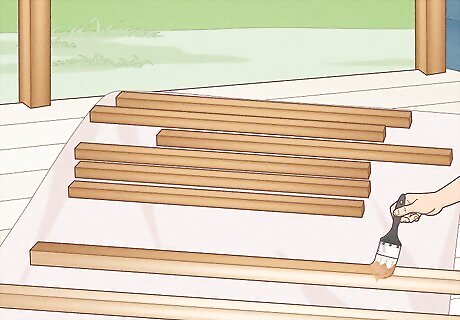
Finish all of the wooden pieces. If you want to apply a finish to your deck, such as a coat of polyurethane or paint, do this before assembly. Coat all of the pieces on all sides, and let them dry for about 24 hours. That way, the pieces will be more protected from weather conditions. Handyman Walter Brant advises "sealing the end of each cut piece of wood to prevent water from entering. If the wood is not pressure-treated, paint the cut surface with exterior paint; if it is pressure-treated, press clear exterior caulk into the surface." Really push the paint or caulk into place, because you want it to fill all of the pores. Make sure you've finished cutting, sanding and drilling everything before you apply a finish. Let the finish dry completely before assembly to avoid smudges.
Assembling the Balusters
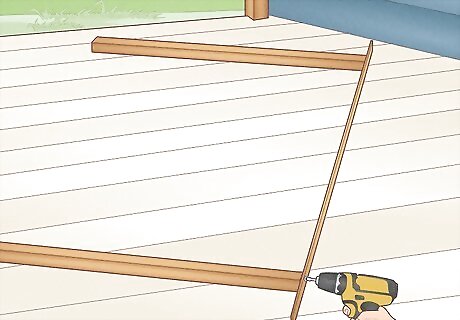
Attach balusters near the ends of a thin strip of wood. Most building codes require that balusters are no more than 4 inches (10 cm) apart. So, if you want them to be 3 inches (7.6 cm) apart, for instance, take one of the thin strips of wood you had cut. Screw the square end of one baluster to the flat surface 3 inches (7.6 cm) from one end of the strip, and another 3 inches (7.6 cm) from the other end of the strip. Screws that are 1.5 inches (3.8 cm) to 2 inches (5.1 cm) should be fine.
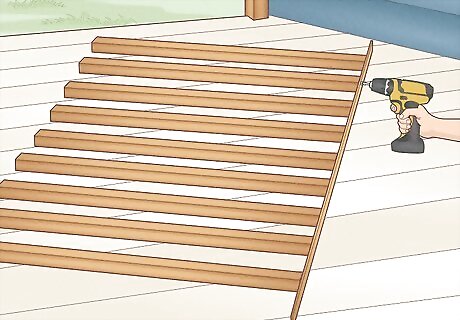
Position the other balusters and attach them to the strip. Space the other balusters evenly along the strip between the two you already attached. Drive screws that are 1.5 inches (3.8 cm) to 2 inches (5.1 cm) through the strip and into the ends of the balusters. For instance, you could spread your balusters every 3 inches (7.6 cm) along the strip, then screw them in. If measuring out the place for each baluster seems too tedious, take advantage of an online deck railing calculator to do the hard work for you.
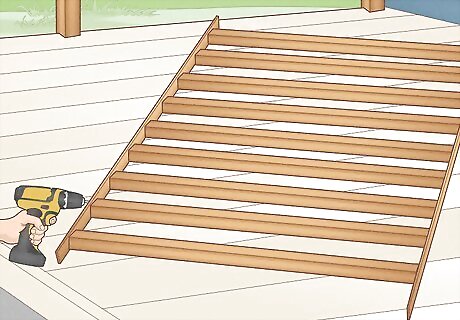
Screw another thin strip to the bottom of the balusters. Once you have the tops of the balusters attached to one of the strips, lay another one along their bottoms. Drive screws that are 1.5 inches (3.8 cm) to 2 inches (5.1 cm) long through it into the balusters. This will hold them all securely in place.
Installing the Rail
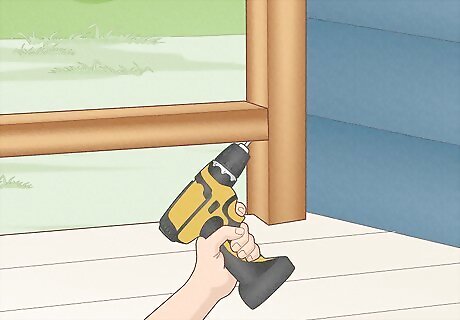
Secure the bottom rail to the posts. Use a couple of scraps of wood to hold the bottom rail up at the height you want it to be. Pre-drill holes at an angle through its bottom, toward the posts. Then drive long screws through these holes and into the posts so that the bottom rail will stay securely in place. Screws that are 3 inches (7.6 cm) to 4 inches (10 cm) long should be fine.
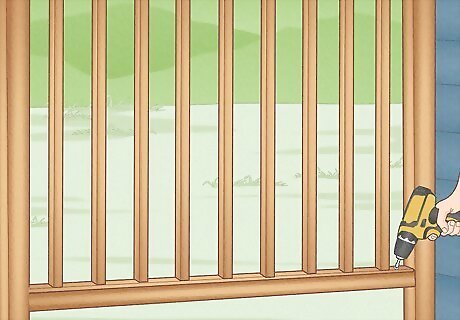
Set the balusters assembly on the bottom rail. Position the thin strip holding the balusters together on the center of the bottom rail. Drive a few screws (that are no longer than your bottom railing is thick) through the thin strip into the lower rail.
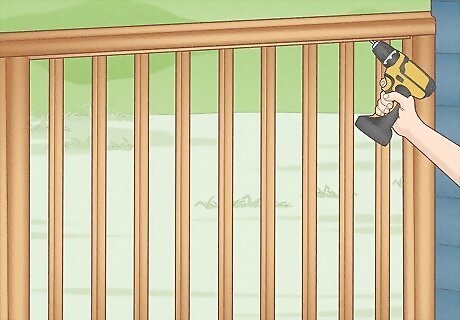
Lay the top rail down. Set it on top of the other thin strip holding the balusters in place. Drive a few screws (that are no longer than your top rail is thick) from underneath, through the thin strip and into the bottom of the top rail. Now the pieces of the rail will be securely attached to each other and to the posts.
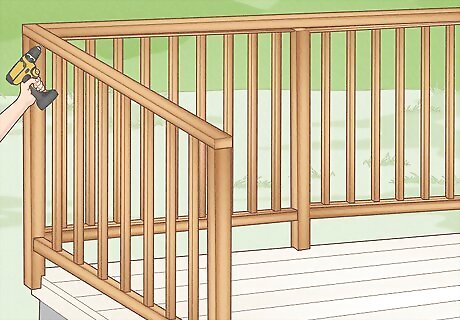
Repeat for other sections of railing. If your deck will have multiple sections of railing between other posts, repeat this process. Measure the distance between the posts, build the baluster assemblies, and attach them to the top and bottom rails.













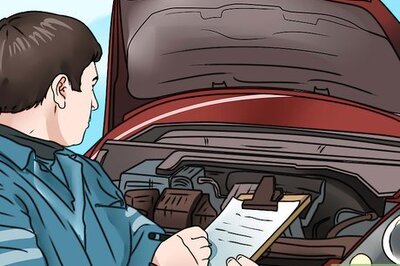




Comments
0 comment